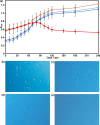Reclassification of the Specialized Metabolite Producer Pseudomonas mesoacidophila ATCC 31433 as a Member of the Burkholderia cepacia Complex
- PMID: 28439036
- PMCID: PMC5472815
- DOI: 10.1128/JB.00125-17
Reclassification of the Specialized Metabolite Producer Pseudomonas mesoacidophila ATCC 31433 as a Member of the Burkholderia cepacia Complex
Abstract
Pseudomonas mesoacidophila ATCC 31433 is a Gram-negative bacterium, first isolated from Japanese soil samples, that produces the monobactam isosulfazecin and the β-lactam-potentiating bulgecins. To characterize the biosynthetic potential of P. mesoacidophila ATCC 31433, its complete genome was determined using single-molecule real-time DNA sequence analysis. The 7.8-Mb genome comprised four replicons, three chromosomal (each encoding rRNA) and one plasmid. Phylogenetic analysis demonstrated that P. mesoacidophila ATCC 31433 was misclassified at the time of its deposition and is a member of the Burkholderia cepacia complex, most closely related to Burkholderia ubonensis The sequenced genome shows considerable additional biosynthetic potential; known gene clusters for malleilactone, ornibactin, isosulfazecin, alkylhydroxyquinoline, and pyrrolnitrin biosynthesis and several uncharacterized biosynthetic gene clusters for polyketides, nonribosomal peptides, and other metabolites were identified. Furthermore, P. mesoacidophila ATCC 31433 harbors many genes associated with environmental resilience and antibiotic resistance and was resistant to a range of antibiotics and metal ions. In summary, this bioactive strain should be designated B. cepacia complex strain ATCC 31433, pending further detailed taxonomic characterization.IMPORTANCE This work reports the complete genome sequence of Pseudomonas mesoacidophila ATCC 31433, a known producer of bioactive compounds. Large numbers of both known and novel biosynthetic gene clusters were identified, indicating that P. mesoacidophila ATCC 31433 is an untapped resource for discovery of novel bioactive compounds. Phylogenetic analysis demonstrated that P. mesoacidophila ATCC 31433 is in fact a member of the Burkholderia cepacia complex, most closely related to the species Burkholderia ubonensis Further investigation of the classification and biosynthetic potential of P. mesoacidophila ATCC 31433 is warranted.
Keywords: antibacterial; antibiotic resistance; biosynthesis; bulgecin; genome; identification; metal resistance.
Copyright © 2017 Loveridge et al.
Figures



References
-
- Templin MF, Edwards DH, Höltje JV. 1992. A murein hydrolase is the specific target of bulgecin in Escherichia coli. J Biol Chem 267:20039–20043. - PubMed
Publication types
MeSH terms
Substances
Grants and funding
LinkOut - more resources
Full Text Sources
Other Literature Sources
Miscellaneous

